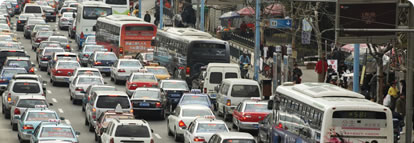Vehicle Safety Challenges and Opportunities
Traffic safety is a growing public health challenge, particularly in developing countries. Worldwide, approximately 1.2 million people die each year in traffic accidents. The vast majority of those fatalities – more than 1 million – occur in countries with low- and middle-income economies.

Shanghai, China
The World Health Organization reports that traffic accidents were the ninth leading threat to global public health in 1990, but such accidents are expected to rise to the third leading threat by 2020. All of that projected increase is forecast to take place in low- and middle-income countries; high-income countries are actually expected to see a decrease of 30 percent in traffic deaths between 2000 and 2020. Many of the traffic deaths in developing nations involve pedestrians and/or motorcycles. As mobility increases in developing markets, people initially use two-wheeled motor vehicles, and the incidence of traffic accidents rises. As people migrate to automobiles, traffic accidents and injury levels generally then decrease.
During this transition, holistic solutions are required, including infrastructure improvements, the modification of road user behavior and the enforcement of traffic laws. One critical task is to educate drivers regarding the most important primary safety feature – safety belts. Continued improvements in vehicle safety are also important, and we at Ford continue to take seriously our responsibility to build safe vehicles. Increasingly, we have also become more involved in encouraging new and innovative ways to modify road user behavior (for example, through new technologies and driver education efforts) and encouraging infrastructure and enforcement improvements in the communities in which we operate. This vehicle safety section details our latest efforts and achievements in all of these areas.
Findings of the Materiality Analysis
We analyzed the importance of vehicle safety to our Company and stakeholders as part of the materiality analysis conducted for our 2006/7 report. In that analysis, vehicle safety was identified as one of a small set of material issues for the Company. Customers are showing greater concern for vehicle safety and making it a higher priority in purchase decisions, while other stakeholders, including NGOs, tend to focus on particular aspects of safety. There is a trend toward increased regulation of vehicle safety worldwide, and inconsistent regulations can create barriers to trade. An emerging societal and competitive issue for us at Ford is how to respond to the growing consumer interest in in-vehicle communication, navigation and entertainment systems while maintaining or improving vehicle safety (see Materiality Analysis).
RELATED LINKS
- In This Report
- External Web Sites